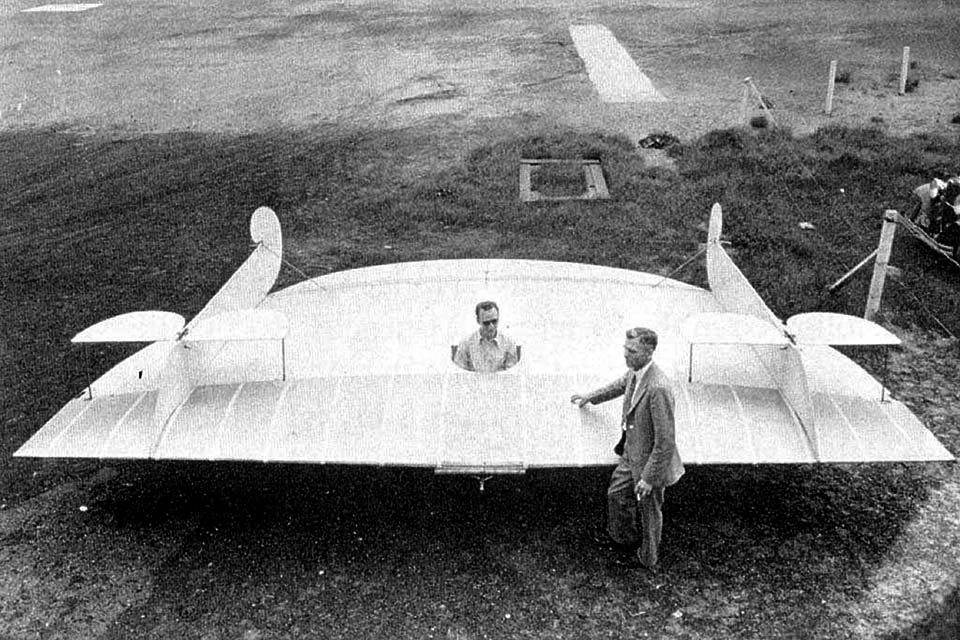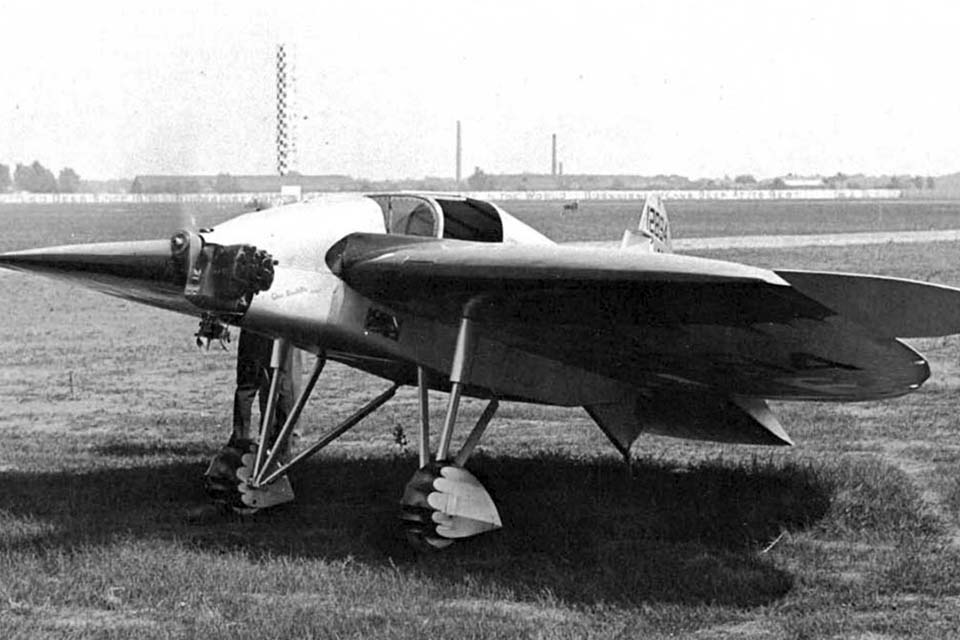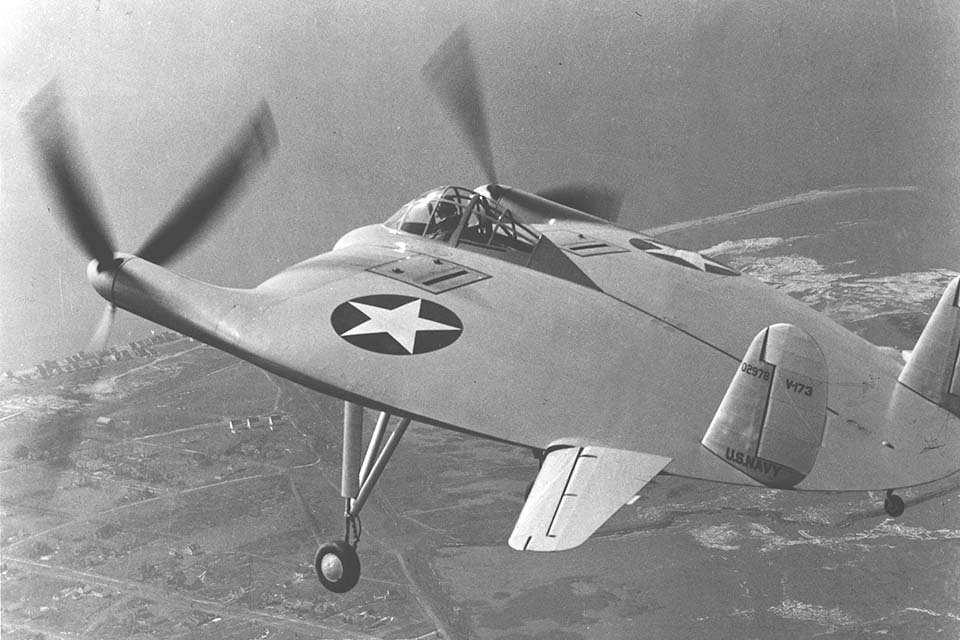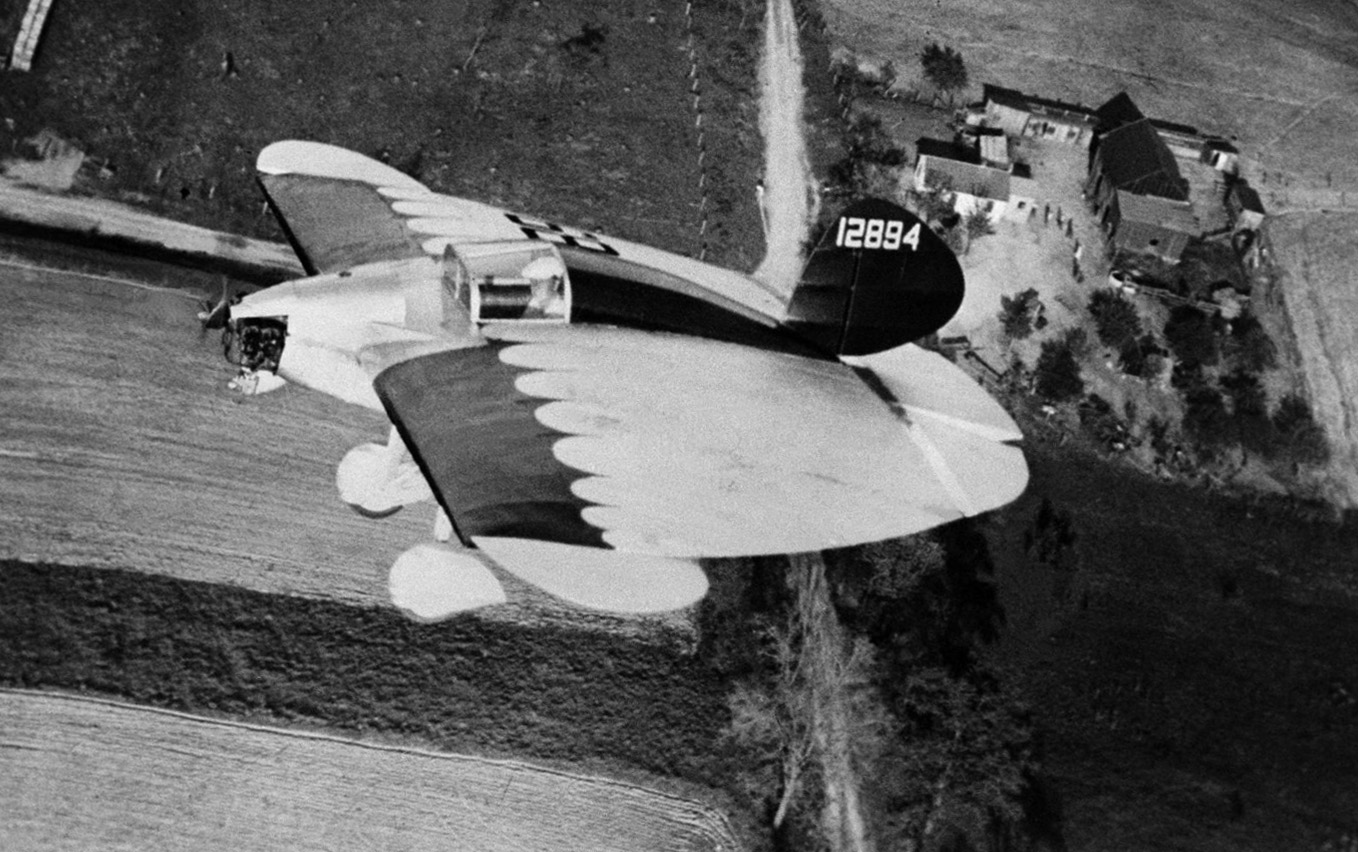During the interwar years, a Midwestern podiatrist designed one of the most radical aircraft ever to take wing.
By the 1920s, the basic configuration of the airplane as we know it today was pretty much settled: an elongated fuselage with vertical and horizontal control surfaces at the tail, and wings, with ailerons for lateral control on their trailing edges, joined to the fuselage near the center of gravity. But there were still a few freethinkers around who were not yet persuaded that was the best way to go. They included Juan de la Cierva, who thought an airplane ought to be supported in the air by a set of rotating blades; Vincent Burnelli, who believed the fuselage shape should be sculpted to contribute to the airplane’s lift; Jack Northrop, who thought the fuselage and tail ought to be omitted altogether, leaving nothing but the wing; and Luigi Stipa, who instead sought to eliminate the wings, with the fuselage shaped into the form of a hollow, tubular lifting body.
And then there was Dr. Cloyd L. Snyder, a podiatrist from Plymouth, Ind. In 1926, during what was presumably a slow day at the office, Snyder sat idly flipping felt heel inserts into the air. Apparently they soared so well that it occurred to him the shape of a heel lift might make a pretty good airfoil. Though he had no aeronautical training, Snyder proceeded to design an airplane shaped like a heel lift. He went on to build flying models and develop a full-size glider prototype. In 1930 the podiatrist applied for a patent for his radical new configuration, which was granted in 1932. He then formed Arup Inc. to build his aircraft.

The 1920s and ’30s was a simpler time for aviation. One didn’t require the combined resources of Lockheed Skunk Works, NASA and the brain trust of MIT, as well as near-limitless funding, to develop a new type of aircraft. Back then, any farm boy could aspire to build the fastest airplane in the world in a vacant shed. In fact, the Granville brothers of Springfield, Mass., did just that when they created their famous Gee Bee racers.
Snyder recruited a few friends and associates to help him build and test his radical new design, among them Raoul Hoffman, who actually knew something about designing and building airplanes, having helped to develop the Laird Super Solution racer. Another of Snyder’s associates, Milton Hatfield, an aspiring pilot and homebuilt airplane constructor, donated his time, building materials and an airplane engine in exchange for flying lessons. The fledgling firm’s test pilot was Glenn Doolittle, a cousin of legendary racing and test pilot Jimmy Doolittle.
Snyder initially dubbed his glider the Dirigiplane because he intended to increase its lift by filling the airfoil with helium—though no evidence exists of that ever being done. He later changed the aircraft’s name to Monowing, and finally settled on Arup S-1. Shaped exactly like a heel insert, his creation was what aeronautical engineers might call a lifting body, since it had no separate fuselage and wings. It could also have been characterized as a low-aspect-ratio flying wing, because it had a very short span and a very long chord. That meant the Arup was the antithesis of Jack Northrop’s flying wing concept, as epitomized by the B-2 stealth bomber, which features a relatively long span and narrow chord.
Viewed from above, the S-1 has been described as resembling a fingernail or a guitar pick. For control surfaces it had two long vertical stabilizers, terminating in small rudders. The elevator was inset into the lifting surface’s trailing edge, with four small ailerons mounted above and a little behind the leading edge. The pilot sat in an open cockpit in the middle of the lifting surface, near the center of gravity. The S-1 apparently flew quite well when towed behind a car.
The next step was to build a powered prototype, the S-2, which resembled the S-1 glider in general shape, though it differed in the arrangement of the cockpit, controls and landing gear. Constructed of steel tubes and wood, and covered with fabric, the S-2 was based upon the flat-bottom NACA M6 airfoil section. It weighed in at 780 pounds. The wing-body was 17 feet 2 inches long and had a span of only 19 feet, resulting in an aspect ratio of 1-to-132. The S-2 had a single fin and rudder mounted near the rear of the wing, the trailing edge of which comprised a large movable elevator surface. Lateral control was provided by pivoting semicircular “ear” ailerons attached to the wingtips, just behind the leading edges. The pilot sat on the centerline, slightly aft of the wing’s leading edge, in an enclosed cockpit with a sliding canopy—a novel feature on any airplane in 1932. Milt Hatfield’s 37-hp Continental A-40 engine was mounted in front of the cockpit. The landing gear was quite tall in order to produce the high angle of attack needed to generate maximum lift at low speeds.

First flown in 1932, the S-2 was undoubtedly one of the most unusual-looking airplanes ever to take wing, but it handled well. It could take off and climb out at a very steep angle, had a top speed of 97 mph and landed at a mere 23 mph. Extremely maneuverable, it was allegedly spin-proof. (You can see footage of the S-2 taking off, flying and landing on YouTube.)
The S-2’s performance would be considered pretty impressive today even if it had been developed by aeronautical engineers using computers and space-age materials. For an airplane developed by nonprofessionals, and virtually home-built using 1930s materials, it comes pretty close to sensational.
Snyder had ambitious plans for the Arup design. He envisioned one version as a sort of flying Ford Model T, an aircraft that anybody could afford. He also planned on a larger version, with a 100-foot span, in which passengers could ride inside the airfoil. He had the S-2 publicized in various periodicals and flown at a variety of venues, including the Indianapolis 500 auto race. He also took his invention to Washington, D.C., where it was demonstrated before the U.S. Army Air Corps, the Civil Aeronautics Authority and the National Advisory Committee for Aeronautics. In spite of its excellent performance, however, the S-2 generated little interest. Maybe it looked too different, or perhaps the Depression-era public just wasn’t receptive to radical new products.
Snyder attempted to build a larger version, the S-3, with an enclosed cabin that was accessed from a door in the belly. Although the S-3 was never completed due to sabotage, an improved version, the S-4, was constructed and flown in 1934. Apart from its cabin, the S-4 differed from the S-2 in having a conventional tail and elevators, and ailerons inset into the airfoil in place of the S-2’s pivoting ear ailerons. It had a 22-foot wingspan and was powered by a 70-hp Leblond 5DE radial engine. Like the S-2, the S-4 proved safe and stable in flight, and featured excellent STOL performance.
The Arup Corporation eventually went out of business due to lack of funds, but both aircraft continued to fly for many years, earning a living as aerial billboards. Neither ever experienced a crash. Both were reportedly scrapped during World War II, but a replica of the S-4 is now on display in St. Joseph Regional Airport at South Bend, Ind.

Although Dr. Snyder’s Arup didn’t sell, that wasn’t quite the end of his design. In 1936 Raoul Hoffman built his own Arup-type aircraft in St. Petersburg, Fla., dubbed the Hoffman Flying Wing, which caught fire and crashed on its maiden flight. In the 1970s Milt Hatfield revived the configuration in a successful homebuilt aircraft of his own design, which he called the Little Bird. Today the Arup configuration continues to intrigue—and inspire—many homebuilders and flying-model makers.
The most ambitious Arup derivative to date is undoubtedly the XF5U, developed by Vought during WWII as a twin-engine STOL carrier-based fighter. Based upon the earlier V-173 “Flying Pancake” aerodynamic research prototype, the XF5U prototype was completed but never actually flown because funding dried up after the war. The designer of both the V-173 and XF5U, Charles H. Zimmerman, had been among the NACA officials who witnessed the Arup S-2 demonstration in Washington.
Originally published in the March 2013 issue of Aviation History. To subscribe, click here.





